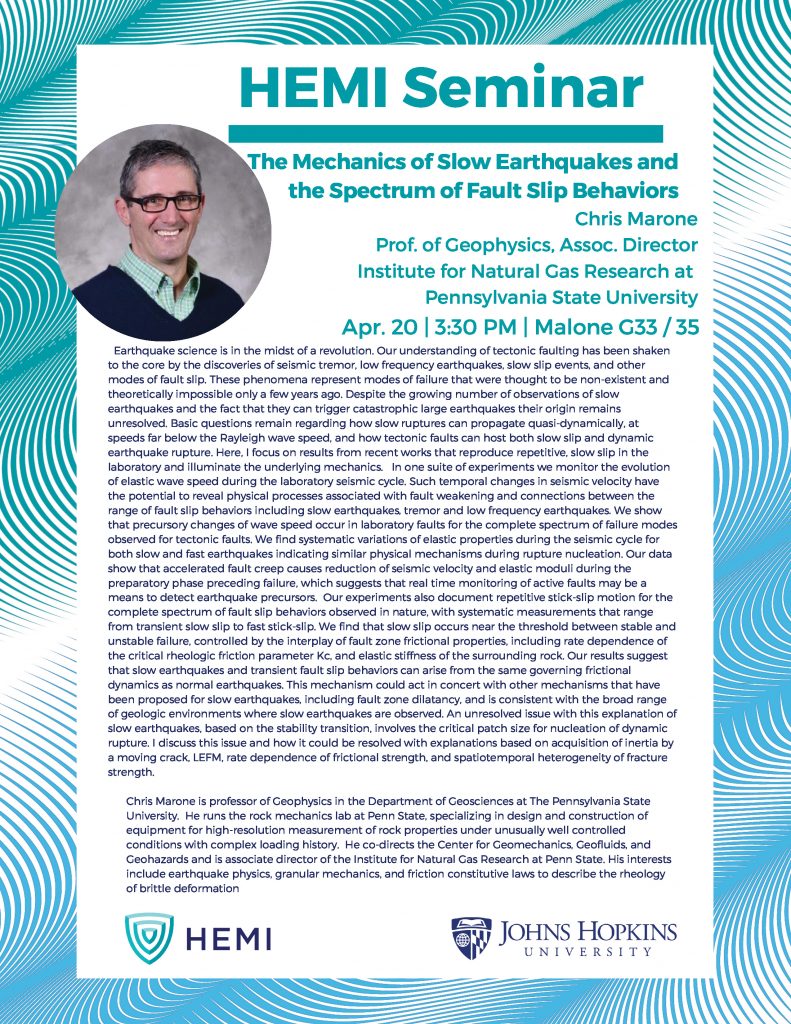April 20, 2018 @ 3:30 pm - 4:30 pm
Event Navigation
The Mechanics of Slow Earthquakes and the Spectrum of Fault Slip Behaviors
Lead by Prof. Chris Marone
Earthquake science is in the midst of a revolution. Our understanding of tectonic faulting has been shaken to the core by the discoveries of seismic tremor, low frequency earthquakes, slow slip events, and other modes of fault slip. These phenomena represent modes of failure that were thought to be non-existent and theoretically impossible only a few years ago. Despite the growing number of observations of slow earthquakes and the fact that they can trigger catastrophic large earthquakes their origin remains unresolved. Basic questions remain regarding how slow ruptures can propagate quasi-dynamically, at speeds far below the Rayleigh wave speed, and how tectonic faults can host both slow slip and dynamic earthquake rupture. Here, I focus on results from recent works that reproduce repetitive, slow slip in the laboratory and illuminate the underlying mechanics.
In one suite of experiments we monitor the evolution of elastic wave speed during the laboratory seismic cycle. Such temporal changes in seismic velocity have the potential to reveal physical processes associated with fault weakening and connections between the range of fault slip behaviors including slow earthquakes, tremor and low frequency earthquakes. We show that precursory changes of wave speed occur in laboratory faults for the complete spectrum of failure modes observed for tectonic faults. We find systematic variations of elastic properties during the seismic cycle for both slow and fast earthquakes indicating similar physical mechanisms during rupture nucleation. Our data show that accelerated fault creep causes reduction of seismic velocity and elastic moduli during the preparatory phase preceding failure, which suggests that real time monitoring of active faults may be a means to detect earthquake precursors.
Our experiments also document repetitive stick-slip motion for the complete spectrum of fault slip behaviors observed in nature, with systematic measurements that range from transient slow slip to fast stick-slip. We find that slow slip occurs near the threshold between stable and unstable failure, controlled by the interplay of fault zone frictional properties, including rate dependence of the critical rheologic friction parameter Kc, and elastic stiffness of the surrounding rock. Our results suggest that slow earthquakes and transient fault slip behaviors can arise from the same governing frictional dynamics as normal earthquakes. This mechanism could act in concert with other mechanisms that have been proposed for slow earthquakes, including fault zone dilatancy, and is consistent with the broad range of geologic environments where slow earthquakes are observed. An unresolved issue with this explanation of slow earthquakes, based on the stability transition, involves the critical patch size for nucleation of dynamic rupture. I discuss this issue and how it could be resolved with explanations based on acquisition of inertia by a moving crack, LEFM, rate dependence of frictional strength, and spatiotemporal heterogeneity of fracture strength.
Bio:
Chris Marone is professor of Geophysics in the Department of Geosciences at The Pennsylvania State University. He runs the rock mechanics lab at Penn State, specializing in design and construction of equipment for high-resolution measurement of rock properties under unusually well controlled conditions with complex loading history. He co-directs the Center for Geomechanics, Geofluids, and Geohazards and is associate director of the Institute for Natural Gas Research at Penn State. His interests include earthquake physics, granular mechanics, and friction constitutive laws to describe the rheology of brittle deformation.





